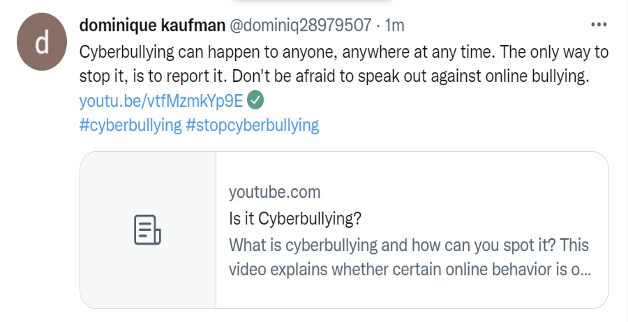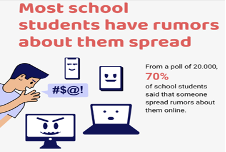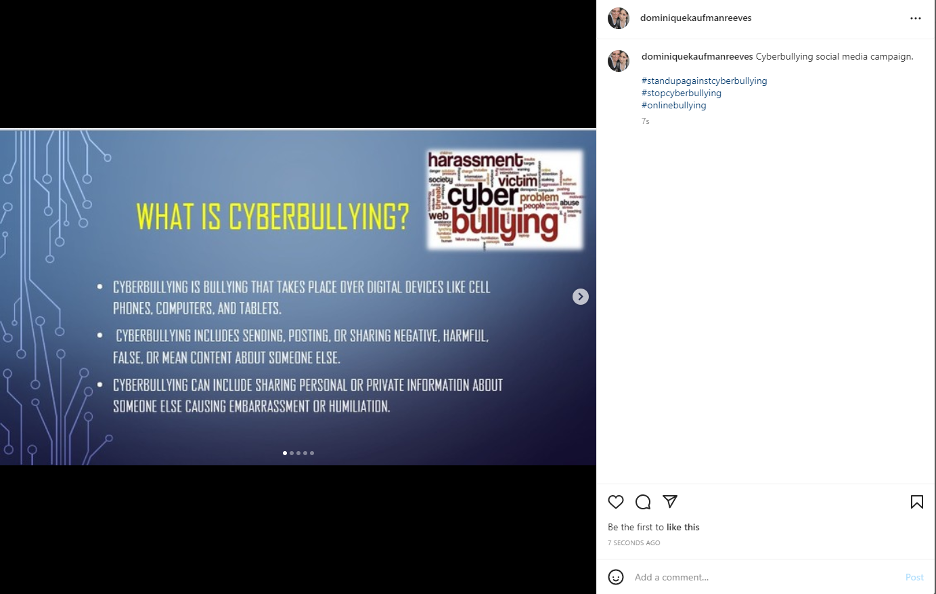Overview of Spreadable Media Content Campaign
Below are the three Twitter posts I have carefully designed to spread awareness on cyberbullying: what it is, what to look for, what can happen if you or someone you know is being bullied online and how to get help.

Figure 1. 1st Media post for Twitter with attached YouTube link.


Figure 2. 2nd Media Post for Twitter with personalized meme.


Figure 3. 3rd Media Post for Twitter with cyberbullying information image.
The first Twitter post was designed to explain to my audience how important it is to make sure that if you or someone you know is being bullied or harassed online, you should find someone you trust and report the issues you are having. I included a link to a YouTube video to explain what cyberbullying is, what to look out for, and the process of reporting someone for cyberbullying (Figure 1). The second Twitter post is a few sentences on how cyberbullying can affect your mental, physical, and emotional health and the meme I created to help support my statement (Figure 2). In the third Twitter post, I wanted to make sure I included facts on how often school-aged students deal with cyberbullying, so if someone reads this post who is possibly being bullied online, they can see that they are not alone and this is a serious issue that happens to many people (Figure 3). I finished all of these posts with the same hashtag, #stopcyberbullying, so if someone where to type into Twitter #cyberbullying or #stopcyberbullying, all of these posts would appear in the same place.
The next 5 images showcase the Instagram post I designed to spread my social media issue on cyberbullying (Figures 4-8). With Instagram, I had a lot more room to work with for my post, so I was able to go into a lot more detail as far as text, graphs, and images to get my message across to my intended audience. I combined all 5 slides into one post that you can scroll through to read each one. I used similar hashtags to the ones I used for the Twitter posts to keep them cohesive, since the goal is to reach a similar audience, just on two different platforms.

Figure 4. First page of Instagram Post

Figure 5. Second page of Instagram Post

Figure 6. Third page of Instagram Post

Figure 7. Fourth page of Instagram Post

Figure 8. Fifth page of Instagram Post
My Purpose and Intended Audience
The purpose of creating my spreadable media campaign is to raise awareness of the dangers surrounding cyberbullying. This campaign is also meant to inform individuals of the different ways people can bully others online, as well as the different kinds of online platforms that people can get bullied on: Facebook, Instagram, instant messaging, online gaming, etc. The audience I am trying to reach with this campaign is young people, mainly school-aged youth and young adults. Young people are affected every day by cyberbullying, and it is important for them to know how to detect if they or someone they know is being bullied online.
This campaign can also be informative from another perspective. Maybe a young person who happens to be bullying other kids online will see these posts and realize the harm they might be causing others. This campaign is meant to inform and inspire, whether that be to help someone who is being bullied to come forward and seek help, or to help an online bully understand the mental, physical, and emotional damage they could be inflicting on someone else. My purpose is for young people to gain an understanding of what cyberbullying is, what platforms it can present itself on, what damage it can cause, and why they need to come forward if they or someone else is being bullied online.
Will this Content Spread?
The topic I chose to create a media campaign around is not exactly something people will want to read about all the time. It is a hard topic to discuss and read about, especially if it personally has affected you in some way. But topics like cyberbullying are important and should be talked about, especially on the internet where this kind of bullying occurs. I wanted to create content that was not only informative but appealing to my target audience which is young people. Young people are attracted to pictures more than words; and even though my Instagram post’s slides are lengthy, I made sure to add visuals to make the information more engaging. I used a digital looking background for my Instagram slides to go along with the fact that this is a digital based issue being discussed. I wanted it to be colorful but on theme. I used the color blue as the background color for the Instagram slides to give off the message that this is a serious message that does have a sad undertone. Jenae Cohn says that, “Color can help evoke emotions in the viewer while also helping the viewer distinguish what’s important or what should be emphasized.” I made sure to use this when designing my slides. I used yellow for my headings because they stood out against the blue background, making them easy to read and focus on what is being discussed in each slide. I also used red lettering on the small captions on some of the bottoms of the slides. I chose red because we see that color as a STOP, like a stop sign; I wanted those captions to make an important final statement.
The Twitter posts are a lot shorter but pack a significant punch. I wanted each post to have its own independent design to make people notice it and want to read it. There are similar words with each post, but each tweet has something different. One post has a meme that I created specifically for this campaign, which I made very youth friendly (Figure 2). I took the image from the movie Inside Out and chose the sadness character because I want the audience to realize that cyberbullying can cause a lot of mental and emotional damage to people. On another post, I have an image with the message that reads “Most school students have rumors spread about them” (Figure 3). This is to capture the viewers’ attention and make them want to read what goes along with this statement. The last post has a link to a YouTube video that reads “Is It Cyberbullying” (Figure 1). Nielsen Norman writes, “A link is a promise. To function properly, it must set expectations that are not only specific, but also accurate.” This link is a direct link to a YouTube video which explains what cyberbullying is, and what you can do if you or someone you know is being bullied online (Is It Cyberbullying?)
I believe my content will spread if posted at the right time. Like I mentioned in the beginning this is not a greatly discussed topic, but it is a topic that affects the majority of school aged youth at some point in their lives. I have made sure to provide as much information as possible within the space that each platform provides. I made sure that each post or slide is easy to read, has detailed information and has some kind of image, video link, or graph to help support my campaign issue. It might not be the most interesting topic or a viral dance video on TikTok, but I believe that what I have created is a campaign that can help a lot of youth deal with online bullying.
Where to Circulate my Campaign
I chose Twitter and Instagram as the platforms for my cyberbullying campaign because of what the platforms allow you to do. I chose Twitter for my multiple multimedia posts because Twitter is a platform that allows you to not only post a written message but images or videos along with it. I knew that I wanted to break up my content into multiple smaller posts for a quicker, easy to read message about cyberbullying, so Twitter was the place to do that. It is a platform that also allows for people to like and share the post. This is about spreadability, the more people that like and share, the more the message gets viewed by people who need it. Twitter is also a platform that incorporates a lot of memes and videos on their platform and I knew I wanted to incorporate that kind of content into my campaign.
Instagram is a similar platform to Twitter, but to me is more image based. It is a platform where people post a lot of pictures, so I knew this would be the place that I could create more of an infographic style post. On Instagram, I was able to create multiple slides with my content and upload them all into one post. Instagram allows up to 10 photos per post, so I created 5 slides or images and added the hashtags #standupagainstcyberbullying #stopcyberbullying and #onlinebullying to the caption box.
When to Circulate my Campaign
This was one of the most important components of my campaign and how it is going to spread. This is a very different post than what people are used to seeing on social media, so timing is key to spreadability. I have chosen very specific times throughout the year that will make this content relevant and make the possibility of people reading the posts even higher. First, during National Suicide Prevention Week in the United States, which in 2022 will begin on Sunday, September 4th and end on Saturday, September 10th. Cyberbullying can lead and has led to many children and young adults committing suicide, so I believe that this campaign can make a big impact during this week of the year. Next is during the month of October, which is National Bullying Prevention Awareness Month, so this would also be another great opportunity for this campaign to bring more information to these social media platforms on cyberbullying. The last time during the year that I feel this campaign would gain spreadability would be every third Friday in June, which is Stop Cyberbullying Day. This day was specifically created to bring awareness to the issues surrounding cyberbullying.
Technical Structures
The platforms that we use every day are driven by algorithms and your ability to go viral. If what you post is not trending at that moment, then it will most likely get lost in a sea of other posts. If you want your content to spread, you have to make sure it will be easy for people to respond to what you post and create their own content off of what you created. A good way to make sure this is possible is to create a memorable hashtag for your post. People will remember a hashtag over an entire paragraph of information they have just read. That is why, for my campaign, I created a few memorable hashtags to go along with my content relating to cyberbullying. I created #stopcyberbullying, #cyberbullying, #onlinebullying and #standupagainstcyberbullying. These are hashtags that people can put into a search bar on Twitter or Instagram and easily find any posts related to this topic that people have posted about. I want my posts to be easily accessible for anyone looking for information related to cyberbullying.